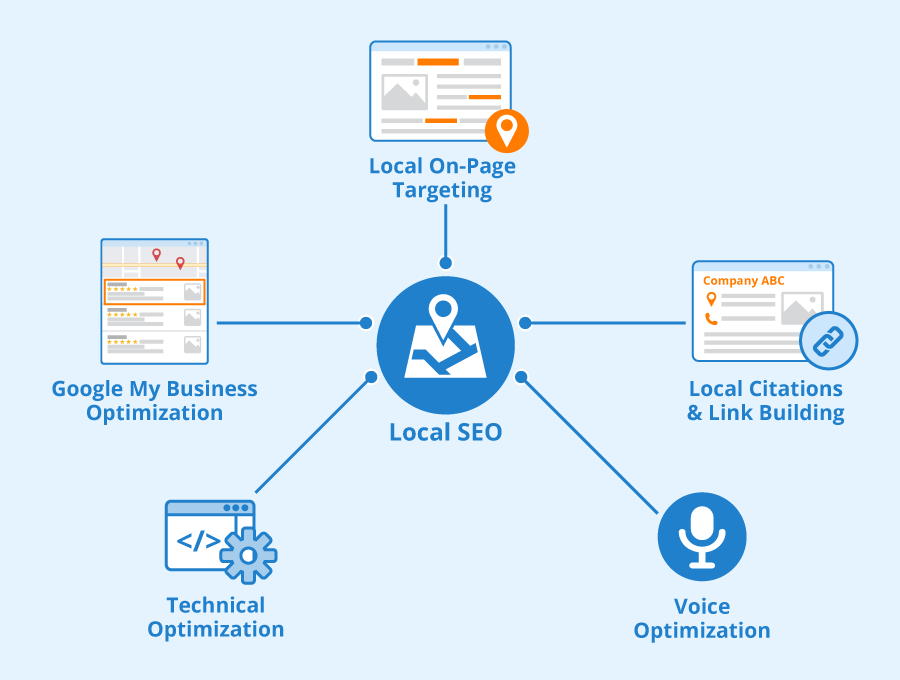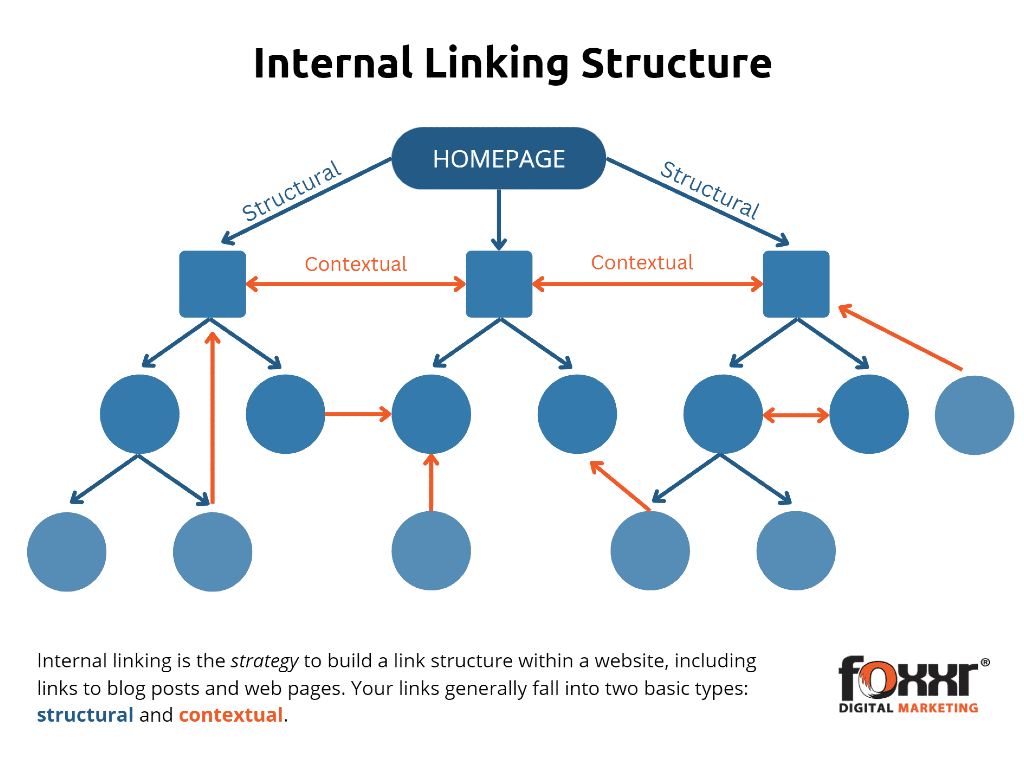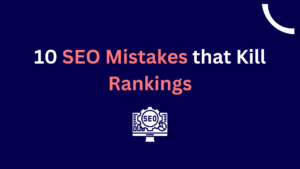In the digital age, the old phrase “build it and they will come” takes on a new meaning. Building a website alone won’t guarantee that people will come.
You need Search Engine Optimization (SEO) to drive your online visibility and success. It’s a powerful tool to attract organic traffic, boost your online presence, and get your site ranked on search engines. But SEO is also complex and ever-changing, making it easy to fall into common pitfalls.
In this blog post, we’ll dive into some of these common SEO mistakes and provide actionable tips to avoid them and improve your rankings.
Common SEO Mistakes
SEO Mistakes #1: Keyword Stuffing
Keyword stuffing was once a common SEO strategy, but with the evolution of search engine algorithms, this approach is not only outdated but harmful to your site’s ranking.
Keyword stuffing refers to the excessive use of targeted keywords in your web content to the point where it appears unnatural and spammy. While it may seem like a good idea to saturate your content with keywords to attract search engines, this practice can lead to penalties from Google and other search engines, ultimately damaging your visibility and credibility.
Google’s algorithms are designed to prioritize high-quality, relevant, and valuable content for users. Overusing keywords disrupts the natural flow of language and reduces the readability of the content, often providing a poor user experience.
To avoid this common SEO mistake, aim for a balanced and natural use of keywords. Incorporate them organically into your content, ensuring it reads naturally and provides value to your audience. Remember, SEO is not just about appealing to search engines, but also about providing valuable content to your audience.
Tip: Focus on creating high-quality, reader-friendly content. Use keywords naturally and sparingly, and consider using synonyms and semantically related words.
SEO Mistakes #2: Ignoring Meta Descriptions
Meta descriptions are concise summaries of your webpage that appear below the clickable link in search engine results. Often overlooked, meta descriptions play a significant role in SEO by influencing the click-through rate (CTR) from search engine results pages (SERPs) to your website.
While meta descriptions do not directly impact your search engine rankings, they are essential for enticing users to click on your link. By providing a compelling and accurate description of the content on your page, you can persuade potential visitors that your site has the information they are seeking. Google sometimes uses the meta description as a snippet in search results, making it a powerful tool to attract organic traffic.
Ignoring meta descriptions or leaving them blank is a common SEO mistake that can reduce your page’s click-through rate, making it harder to drive organic traffic to your site. Moreover, if you don’t specify a meta description, search engines will often generate one for you, and it may not adequately represent your content or contain your targeted keywords.
Tip: Always include a unique and precise meta description for each page on your website, ensuring that it is informative and contains your targeted keywords. This will not only enhance your site’s relevancy in search engine results but also increase the likelihood of users clicking on your webpage.
SEO Mistakes #3: Neglecting Mobile Optimization
In the modern digital landscape, mobile users constitute a significant portion of internet traffic. Yet, many website owners neglect mobile optimization, a critical SEO aspect, causing their sites to lose out on a substantial potential audience. Mobile optimization ensures that your site renders correctly on mobile devices, providing a seamless user experience.
Mobile optimization is not just about making your website look good on smaller screens. It’s about creating an efficient and enjoyable user experience tailored to mobile users, with accessible navigation, easily readable content, and speedy page loads. When your website is not mobile-friendly, it can frustrate mobile users, leading to higher bounce rates and negatively affecting your SEO.
Google has also shifted towards mobile-first indexing, meaning it primarily uses the mobile version of your content for indexing and ranking. If your site is not optimized for mobile, it can negatively impact your search engine rankings, and you risk losing visibility in mobile searches, which constitute a significant portion of online searches today.
Tip: Prioritize mobile optimization for your website. Ensure your site is responsive, has a user-friendly design for mobile, and delivers fast load times. Consider using Google’s Mobile-Friendly Test tool to see how well your website performs on mobile devices and make the necessary adjustments.
SEO Mistakes #4: Slow Site Speed
Slow site speed is a common yet overlooked problem that not only frustrates users but also negatively impacts search engine optimization (SEO). Users typically expect a webpage to load within 2 seconds. Any delay beyond this can lead to an increase in bounce rate as users tend to abandon sites that take too long to load. This can significantly affect your site’s user engagement metrics, including session duration and pages per session, thereby negatively impacting your site’s SEO performance.
Furthermore, search engines like Google take site speed into account when determining search engine rankings. In fact, Google’s algorithm considers page speed as one of the signals used by its algorithm to rank pages. Slow-loading sites are likely to be ranked lower, making them less visible to potential visitors. This can severely limit the amount of organic traffic your site receives.
Tip: To improve your site speed, consider strategies such as optimizing images, leveraging browser caching, reducing server response time, and minimizing the use of render-blocking JavaScript and CSS in above-the-fold content. Regularly monitor your site’s speed using tools such as Google’s PageSpeed Insights.
SEO Mistakes #5: Not Using Analytics Tools
Neglecting to use analytic tools can lead to a severe loss of crucial insights for your website. These tools allow you to understand your users’ behavior, identify any issues on your site, and uncover opportunities for improvement. They can help you track a variety of metrics, such as visitor counts, bounce rates, session durations, and pages per session. These insights can inform your SEO strategy, helping you to improve your site’s performance in search engine rankings.
Further, analytics tools can provide you with demographic information about your site’s visitors, such as their location, age, and device type. This data can help you tailor your content and design to your audience, improving user experience and engagement.
Notably, Google provides a comprehensive analytics tool, Google Analytics, which is widely used and offers robust features. However, there are numerous other analytics tools available, each with their unique features and capabilities.
Tip: Make the most of analytics tools to understand your audience and improve your website’s SEO performance. Regularly monitor your site’s metrics and use the data to inform your SEO strategy. If you’re not already using an analytics tool, consider starting with Google Analytics due to its user-friendly interface and extensive functionality.
SEO Mistakes #6: Forgetting About Local SEO

Local SEO is an often-overlooked aspect of search engine optimization that focuses on improving visibility and rankings for search queries that are locally-oriented or originate from a specific geographic area. This is particularly important for businesses with a physical location or those that offer localized services. A well-optimized local SEO strategy can bring more local traffic to your website and, potentially, to your physical location, leading to increased sales or service bookings.
Factors influencing local SEO include local keyword usage, setting up a Google My Business listing, generating positive local reviews, and ensuring your website’s name, address, and phone number (NAP) consistency across all online listings. Local SEO can help businesses stand out in local search results, target local customers, and compete more effectively against larger national brands.
Tip: To optimize for local SEO, make sure your business is listed in online directories, especially Google My Business. Regularly update your listings with accurate information, including your address, hours of operation, and contact details. Additionally, encourage and respond to customer reviews, use local keywords in your content, and ensure your website is mobile-friendly, as many local searches are made on mobile devices.
SEO Mistakes #7: Skipping Image Optimization
Images can significantly enhance the user experience on your website, but can also play a critical role in your SEO strategy. However, if not optimized correctly, images can slow down your site, leading to a negative impact on both user experience and search engine rankings.
Image optimization involves reducing the file size of your images without compromising on their quality, allowing your pages to load faster. Faster loading pages can lead to better user engagement, retention, and conversions.
Furthermore, search engines cannot ‘see’ images the way humans do. Instead, they rely on the text associated with the image to understand and index it appropriately. This text comes in the form of alt text, captions, and file names. By including relevant keywords in these areas, you can improve your chances of ranking in image search results, and enhance your overall SEO performance.
Tip: Always optimize your images before uploading them to your site. This includes reducing the file size without compromising quality and properly using image alt text and filenames. Remember to incorporate relevant keywords in a natural manner. Use tools like TinyPNG for image compression and Google’s Image Guidelines for more information on optimizing images for SEO.
Recommended: Our 8 step guide to complete Image Optimization for SEO.
SEO Mistakes #8: Creating the Wrong Type of Content
Creating content that is irrelevant or ineffective for your target audience is a common SEO mistake. Quality content is a cornerstone of any successful SEO strategy. However, it’s not just about producing content; it’s about producing the right type of content. This means content that is relevant to your audience, aligns with their needs and interests, and is optimized for search engines. Irrelevant content can result in lower engagement rates and eventually harm your website’s visibility on search engine results pages (SERPs).
Content should be developed around topics and keywords that are pertinent to your industry and audience. Understanding your audience’s informational needs, preferences, and search behavior is crucial to creating relevant content. This involves conducting thorough keyword research and audience analysis to strategize your content creation.
Ineffective content is content that fails to meet its intended objectives, whether that’s to inform, educate, entertain, or convert. It doesn’t resonate with the audience, leading to lower engagement, fewer shares, and ultimately, less visibility in SERPs. To avoid creating ineffective content, make it valuable by providing unique insights, actionable steps, or solving a problem for your audience.
Tip: To avoid creating the wrong type of content, conduct thorough audience research to understand their needs, interests, and search behavior. Build your content strategy around this research, ensuring that your content is both valuable and highly relevant to your target audience. Regularly evaluate the performance of your content and adjust your strategy based on the results. Remember to incorporate relevant keywords naturally into your content to improve its visibility in search results. Use tools like Google Keyword Planner for keyword research and Google Analytics for monitoring content performance.
SEO Mistakes #9: Missing Quality Links
Many SEO strategies focus heavily on on-page tactics, such as keyword optimization and content creation, while neglecting off-page SEO. This imbalance can be detrimental as off-page SEO plays a crucial role in determining how search engines perceive the authority and relevance of your site. A major part of off-page SEO is link building, which refers to the process of acquiring high-quality inbound links from other websites.
Inbound links, also known as backlinks, are links from other websites that direct users to your site. They can significantly influence your site’s search engine rankings, as they are interpreted by search engines as indicators of your site’s credibility and relevance. When reputable, high-authority sites link to your site, it signals to search engines that your content is valuable and reliable, potentially leading to higher rankings in search results.
However, not all backlinks are created equal. Links from high-quality, relevant sites are far more beneficial than links from low-quality or unrelated sites. Google’s algorithms are sophisticated enough to differentiate between these, and having too many low-quality backlinks could even hurt your rankings.
Neglecting off-page SEO and quality link building can result in decreased visibility in search results, as your site may be perceived as lacking authority and relevance. Therefore, it’s essential to incorporate a robust off-page SEO strategy, including quality link building, into your overall SEO approach.
Tip: Focus on acquiring high-quality, relevant links to your site. These can come from well-regarded sites in your industry, guest posts, or high-quality directories. Avoid low-quality, spammy links as these can harm your site’s rankings. Also, ensure your site is full of high-quality, link-worthy content. This increases the likelihood that others will link to your site. Tools like SEMrush and Moz can help you in analyzing your link profile and finding opportunities for improvement.
SEO Mistakes #10: Going Astray with Your Internal Links

A robust internal linking strategy is a key component of effective SEO. However, many businesses neglect the importance of internal links, leading to a site structure that is confusing and difficult to navigate. This can significantly impact your SEO performance, as search engines use internal links to understand the content and structure of your site.
Internal links connect different pages on the same website, providing a roadmap for both users and search engines. For users, a well-structured site with thoughtful internal linking can enhance the user experience by making it easy to find relevant content and navigate the site. For search engines, internal links offer valuable context about your site and its content, helping to determine which pages are most important and how they relate to one another.
However, if your internal linking strategy is lacking, it can lead to a number of SEO issues. First, poor internal linking can result in crucial pages being overlooked by search engines, negatively impacting their organic visibility. Second, it can lead to a poor user experience as users struggle to navigate your site and find the information they need, which can increase bounce rates and damage your rankings.
Thus, it is crucial to maintain a well-structured site with a clear internal linking strategy. Ensure every page is easily accessible through internal links, and that these links provide clear and useful context for both users and search engines.
Tip: One effective way to improve your site’s internal linking is to regularly review and update your links as your content grows. Tools like Screaming Frog’s SEO Spider can be useful for auditing your site’s internal linking structure. Further, creating a sitemap can help search engines understand the structure of your site better. Always aim to create a logical and user-friendly navigation that makes sense to both users and search engines.
Conclusion
SEO is a journey, not a destination. It’s about continuous learning, testing, and adjusting. Yes, it’s easy to make mistakes along the way, but each mistake is an opportunity to learn and improve. The common SEO mistakes highlighted in this post – and the tips to avoid them – can guide you towards better rankings, improved visibility, and ultimately, online success. Remember, the best SEO practices are those that provide value to your users. Focus on creating high-quality, user-friendly experiences, and the rankings will follow. Happy optimizing!

